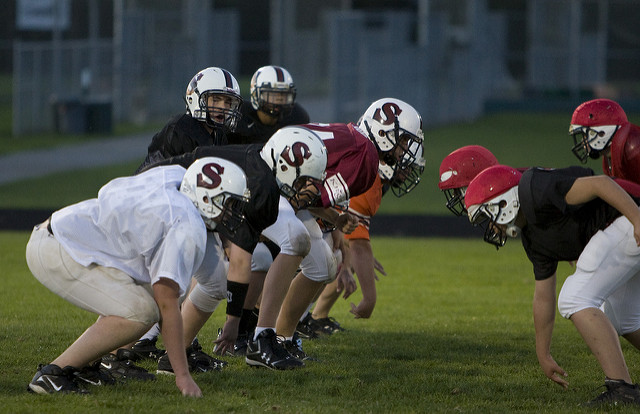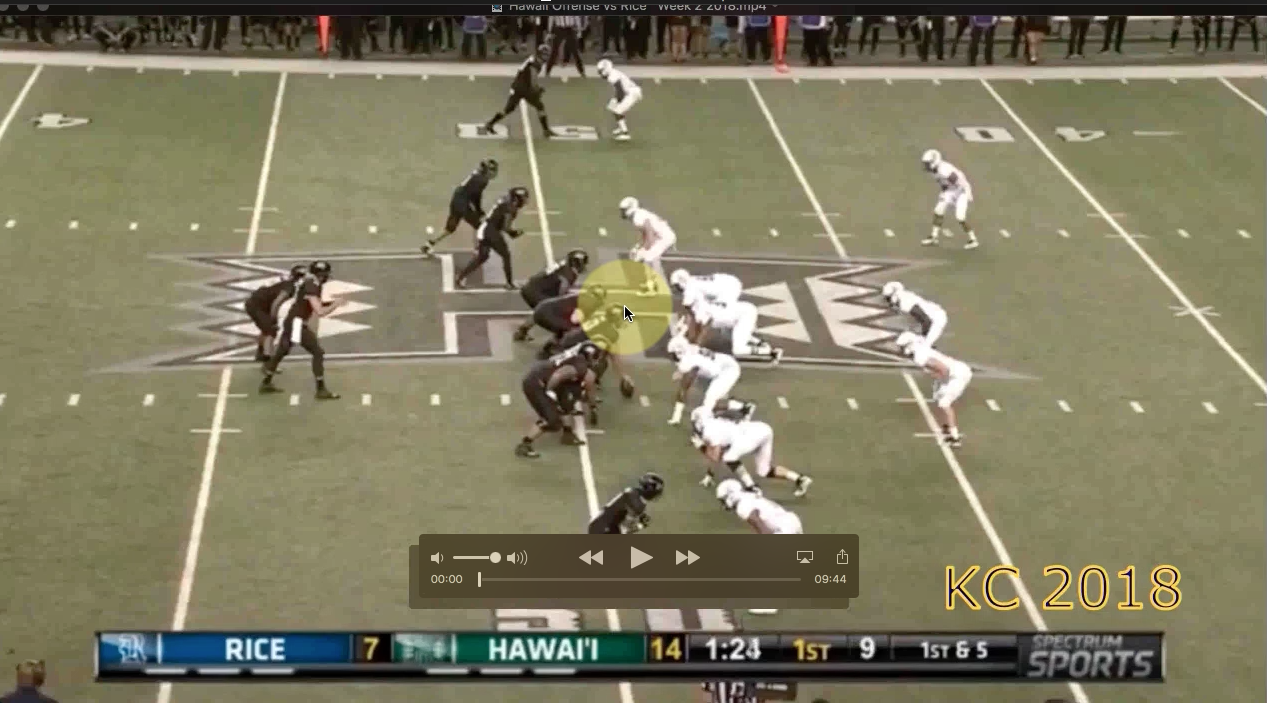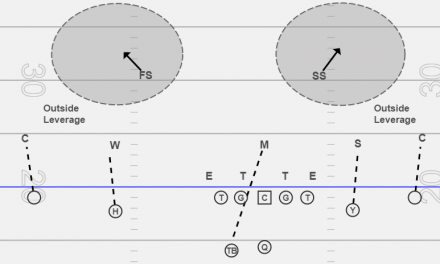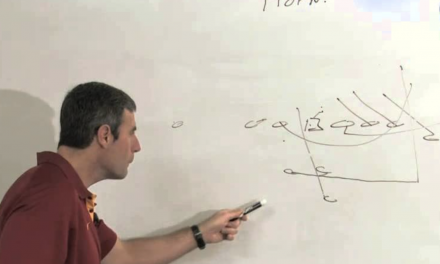A question came from a reader asking how best to create offensive formations with an extra lineman for heavy-style sets.
This is a great question because part of creating a multiple-style offense that you can carry with you from year to year needs to be done by manufacturing easy adjustments to fit your new personnel.
Therefore, how you create these formations needs to be thought out to make it not only easy for your players to learn, but also to keep your play calls or schemes identical to how they would be run out of your base formations.
GOING BACK TO THE FUTURE
As Marty Mcfly taught us, sometimes you need to go backward to make things right again.
Before we begin moving guys into the box, let’s have some fun and discuss how easy of an idea this actually is, by showing how we are actually considering moving backward in football-time to create a future offensive benefit.
As teams began desiring to spread the field over the past fifty years, they had similar personnel in the game as we do today, but had them in much more of a confined space.
When they wanted to better utilize all 53 ⅓ x 100 yards of space, they began taking personnel and moving them out of the box.
All we want to do when creating heavier offensive formations is move in the opposite direction of what we have been doing over years to spread the field, one player at a time.
I did some research and found a few offensive formations that were run long before I even began playing football, as well as the creative formations we still see that stemmed from those:
All of these are formations that were run by championship teams, and can either be used today to get an advantage, or be reviewed to see how they, or things about them, can be added as a package into your offense.
THE STEP-BY-STEP PROCESS
To enable yourself to add an extra lineman to your offensive formations, there are a few considerations you need to make to ensure you have exactly what you want, and to create optimal benefits.
The questions I would suggest asking yourself and your staff are as follows:
HOW DO WE KEEP/GET OUR BEST PERSONNEL IN ALL OFFENSIVE FORMATIONS?
Assuming these offensive formations would be used in important situations, you undoubtedly want to keep your best guys in the game. But, there are some things you want to consider when determining personnel.
The easiest way to create this is by removing your quarterback to bring in an extra lineman (Figure 7).
This will enable you to create an extra gap in the run game, while adding only one more defensive player into the box.
The receivers still need to be covered (we will discuss this later in the article), therefore only one pass defender can enter the box as an extra player, which creates an advantage due to the player being a less aggressive player than the one you are adding.
Another question to ask yourself, is how badly you want your quarterback to stay in the game when running plays from these formations?
If you are going to run the ball 100% of the time as a short-yardage option, then taking your quarterback out would be a great answer, as shown by the figure below (Figure 7).
Not only are you not going to throw the ball, but how often do you want to run your quarterback in between the tackles in a must-run situation.
If you have a Tim-Tebow-style guy, then you may want to have him in there. But if not, and you plan on giving the ball to your tailback, remove your quarterback from the game.
You can replace him with an extra lineman, and snap the ball back to your running back as if he is a quarterback in a gun formation.
If your quarterback is your best player, you can remove your running back or a receiver in place of the offensive lineman you are putting into the game (Figure 8).
The positives of this are that you have the majority of your passing game, while still having the ability to use your entire power run game.
We mentioned the potential problems with the quarterback running frequent power plays, but if you are going to run him anyway, putting him back there by himself while creating an extra gap with an additional lineman may be what gets you a man-advantage.
This is due to the fact that most teams are not going to put defensive backs in the box versus empty formations.
Figure 8 below shows an empty formation, but you can keep the running back in and remove the H to give yourself an extra blocker to create a second extra gap.
The need to get your best players in the game during important situations like this does not stop with your offensive players.
If your defensive personnel are some of your best players, you can add them into the equation as well.
They will most likely not be able to put their hand in the dirt and base block a defender, but if you put them in a position where they can lead block or kick out an end man on the line of scrimmage, you will see explosions more beautiful than July 4th fireworks!!
ARE WE ABLE TO CREATE THE SAME OFFENSIVE FORMATIONS WITH A SINGLE TAG ATTACHED?
Regardless of what formations you choose, before finalizing them, ask yourself if you can run your base plays out of the formations.
This is extremely important, otherwise you are going to have to spend a large portion of your practice time not only getting lined up, but practicing the plays you will need to install the fit into that formation.
The best option is to line up in a formation that not only gets you an extra gap, but allows you to not have to install anything new.
The way to do this is by beginning with your basic formations, and adding a lineman to either the strong side of the weak side.
This method will certainly allow you to run the plays you already practice regularly, and decrease the amount of time you have to practice this package.
Simple examples of how to run through the steps this process are shown in the three figures below:
Removed QB
Removed QB and one WR
HOW DO WE CREATE THE TAGS FOR PERSONNEL CHANGES?
As you begin to create these heavy packages, as mentioned above, you will certainly begin coming up with ideas in which you bring in not only one, but two extra lineman, because you see how easy it is to create new packages without creating new plays.
When you are considering how to most easily signal or name the personnel packages, we have found it best to use a single word to determine who will be going into the game and who will be removed from the game.
And the more offensive lineman you bring in, create an even bigger-sounding word that you can use to help them remember how many extra lineman are entering the game.
For example, concerning figures 9-11, you can use formation names like TE Trips – Giant TE Trips – Elephant TE Trips.
If you check an online thesaurus, there are more words than you can imagine to help the less-creative of us find new package names.
HOW DO WE ADD RPO OPTIONS WITH A RUNNING BACK AT QUARTERBACK?
One thing that may happen to you as you begin to add more lineman, especially if you remove your quarterback, is that teams will blitz defensive backs off of the edge, and leave receivers uncovered.
This makes sense, as the chances of you throwing the ball are slim and none.
So why should the defense not play the percentages.
That being said, if your wildcat running back is able to throw the ball sideways even ten yards, you have your answer.
Any time there is an uncovered receiver, have that receiver turn around and your tailback will throw him the ball.
Even seeing an incomplete pass one time will stop both your current opponent and future opponents from bringing an extra defender.
And if your wildcat running back can throw the ball, the trick play ideas off of outside runs action are endless!
The most likely thing you will begin to see is that when you bring in extra lineman, so will they.
This can definitely create problems, but the answer to this is to come up with your counter-response before they respond with more big guys.
If you can begin to find ways to line up in spread formations with your extra lineman in the game, you will have the answer that will create many sleepless nights for defensive coordinators.
An offensive lineman can most likely stalk-block in space better than a defensive lineman can tackle, get off of blocks, or move laterally in space.
CONCLUSION
As you probably noticed, this article was created using only 11 personnel offensive formations.
If you also want to learn more about other personnel formations – check out the Pro Style Spread Offense that uses 21 personnel formations as its base grouping.
That being said, I believe that no matter what offense you run, you will be able to use these important questions to get your best guys in the game, while continuing to use your current plays to get optimal results.





